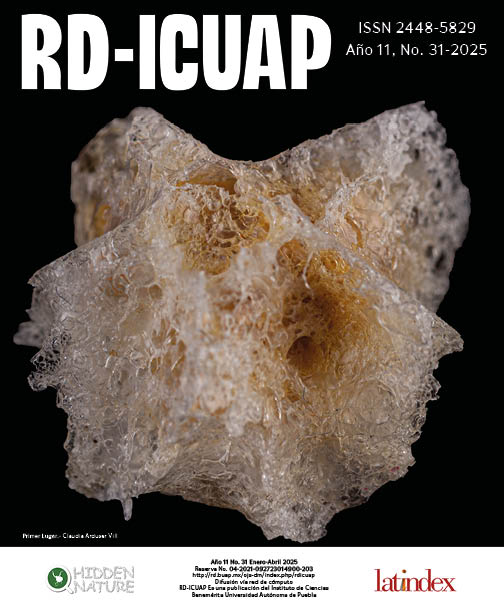SISTEMAS DE INFORMACIÓN GEOGRÁFICA: ALIADOS EN LOS ESTUDIOS SOCIOAMBIENTALES
DOI:
https://doi.org/10.32399/icuap.rdic.2448-5829.2025.31.1553Palabras clave:
Información Geoespacial, Planificación Territorial, Gestión de Recursos, Contaminación Ambiental, Salud PoblacionalResumen
Los Sistemas de Información Geográfica (SIG) son herramientas clave para el análisis y visualización de datos geoespaciales, permitiendo capturar, almacenar, analizar y mostrar información geográficamente referenciada. Los SIG están compuestos por hardware, software, datos geoespaciales, metodologías y usuarios capacitados para su manejo. Estos sistemas permiten una amplia gama de aplicaciones que dependen de sus objetivos de uso como la navegación, el turismo, la construcción y el comercio. En el ámbito socioambiental, los SIG son cruciales para la planificación territorial, el análisis de riesgos y la gestión de los recursos naturales y la biodiversidad. Facilitan el análisis de fenómenos como el cambio climático, la contaminación y la distribución de enfermedades y además, permiten el análisis de la exposición a contaminantes y sus impactos en la salud pública, proporcionando una comprensión más profunda de la relación entre el entorno y las actividades humanas. Su capacidad para adaptar aplicaciones a diversos objetivos los convierte en una herramienta invaluable para la toma de decisiones informadas y en la implementación de intervenciones efectivas.
Citas
Aceves-Quesada, F., López-Blanco, J., & Martin del Pozzo, A. L. (2006). Determinación de peligros volcánicos aplicando técnicas de evaluación multicriterio y SIG en el área del Nevado de Toluca, centro de México. Revista Mexicana de Ciencias Geológicas, 23(2), 113–124.
Alarcón-Herrera, M. T., Martin-Alarcon, D. A., Gutiérrez, M., Reynoso-Cuevas, L., Martín-Domínguez, A., Olmos-Márquez, M. A., & Bundschuh, J. (2020). Co-occurrence, possible origin, and health-risk assessment of arsenic and fluoride in drinking water sources in Mexico: Geographical data visualization. Science of The Total Environment, 698, 134168. https://doi.org/10.1016/j.scitotenv.2019.134168
Allain, M., & Jones, J. (2013). Nonpoint source pollution risk mapping for Alabama’s Big Creek Lake. Geographical Bulletin - Gamma Theta Upsilon, 54(1), 1–23.
Balram, S., Dragićević, S., & Meredith, T. (2004). A collaborative GIS method for integrating local and technical knowledge in establishing biodiversity conservation priorities. Biodiversity and Conservation, 13(6), 1195–1208. https://doi.org/10.1023/B:BIOC.0000018152.11643.9c
Belal, A.-A., El-Ramady, H. R., Mohamed, E. S., & Saleh, A. M. (2014). Drought risk assessment using remote sensing and GIS techniques. Arabian Journal of Geosciences, 7(1), 35–53. https://doi.org/10.1007/s12517-012-0707-2
Burrough, P., & McDonnell, R. (1986). Principles of geographical information systems for land resource assessment. Clarendon Press, Oxford.
Chang, K. (2019). Geographic Information System. In International Encyclopedia of Geography (pp. 1–10). Wiley. https://doi.org/10.1002/9781118786352.wbieg0152.pub2
Gómez Maturano, J. (2024). Redes logísticas de recuperación de residuos sólidos en México: un análisis macroscópico mediante sistemas de información geográfica. Ingeniare. Revista Chilena de Ingeniería, 31. https://doi.org/10.4067/S0718-33052023000100226
Gu, K., Fang, Y., Qian, Z., Sun, Z., & Wang, A. (2020). Spatial planning for urban ventilation corridors by urban climatology. Ecosystem Health and Sustainability, 6(1). https://doi.org/10.1080/20964129.2020.1747946
Hernández-Pérez, E., García-Franco, J. G., Vázquez, G., & Cantellano de Rosas, E. (2022). Land-use change and landscape fragmentation in central Veracruz, Mexico (1989–2015). Madera y Bosques, 28(1), 1–22. https://doi.org/10.21829/myb.2022.2812294
Iriti, M., Piscitelli, P., Missoni, E., & Miani, A. (2020). Air pollution and health: The need for a medical reading of environmental monitoring data. International Journal of Environmental Research and Public Health, 17(7). https://doi.org/10.3390/ijerph17072174
Jalkanen, J., Toivonen, T., & Moilanen, A. (2020). Identification of ecological networks for land-use planning with spatial conservation prioritization. Landscape Ecology, 35(2), 353–371. https://doi.org/10.1007/s10980-019-00950-4
Macharia, P. M., Joseph, N. K., & Okiro, E. A. (2020). A vulnerability index for COVID-19: spatial analysis at the subnational level in Kenya. BMJ Global Health, 5(8), e003014. https://doi.org/10.1136/bmjgh-2020-003014
Masoudi, M., Centeri, C., Jakab, G., Nel, L., & Mojtahedi, M. (2021). GIS-Based Multi-Criteria and Multi-Objective Evaluation for Sustainable Land-Use Planning (Case Study: Qaleh Ganj County, Iran) “Landuse Planning Using MCE and Mola.” International Journal of Environmental Research, 15(3), 457–474. https://doi.org/10.1007/s41742-021-00326-0
Ogato, G. S., Bantider, A., Abebe, K., & Geneletti, D. (2020). Geographic information system (GIS)-Based multicriteria analysis of flooding hazard and risk in Ambo Town and its watershed, West shoa zone, oromia regional State, Ethiopia. Journal of Hydrology: Regional Studies, 27, 100659. https://doi.org/10.1016/j.ejrh.2019.100659
Peña, L. C. B., Córdova, M. O. G., Cejudo, L. C. A., Olave, M. E. T., Murrieta, R. L. M., Aguilar, V. M. S., Villalobos, H. L. R., Gómez, V. M. R., Campos, M. I. U., & León, M. O. G. (2022). Degradation and deforestation in the Conchos river basin (Mexico): Predictive modeling through logistic regression (1985-2016). Cuadernos Geograficos, 61(1), 129–149. https://doi.org/10.30827/cuadgeo.v61i1.21629
Reddy, G. P. O. (2018). Geographic Information System: Principles and Applications (pp. 45–62). https://doi.org/10.1007/978-3-319-78711-4_3
Santos Preciado, J. M. (2020). Sistemas de información geográfica (2020th ed., Vol. 1). Universidad Nacional de Educacion a Distancia Madrid.
Shrestha, M., Piman, T., & Grünbühel, C. (2021). Prioritizing key biodiversity areas for conservation based on threats and ecosystem services using participatory and GIS-based modeling in Chindwin River Basin, Myanmar. Ecosystem Services, 48, 101244. https://doi.org/10.1016/j.ecoser.2021.101244
Wang, F. (2020). Why public health needs GIS: a methodological overview. Annals of GIS, 26(1), 1–12. https://doi.org/10.1080/19475683.2019.1702099
Xie, H., Wen, J., Chen, Q., & Wu, Q. (2021). Evaluating the landscape ecological risk based on GIS: A case‐study in the Poyang Lake region of China. Land Degradation & Development, 32(9), 2762–2774. https://doi.org/10.1002/ldr.3951
Yue, W., Ren, C., Liang, Y., Liang, J., Lin, X., Yin, A., & Wei, Z. (2023). Assessment of Wildfire Susceptibility and Wildfire Threats to Ecological Environment and Urban Development Based on GIS and Multi-Source Data: A Case Study of Guilin, China. Remote Sensing, 15(10), 2659. https://doi.org/10.3390/rs15102659
Descargas
Publicado
Cómo citar
Número
Sección
Licencia
Derechos de autor 2025 RD-ICUAP

Esta obra está bajo una licencia internacional Creative Commons Atribución-NoComercial-SinDerivadas 4.0.
Definir aviso de derechos.
Los datos de este artículo, así como los detalles técnicos para la realización del experimento, se pueden compartir a solicitud directa con el autor de correspondencia.
Los datos personales facilitados por los autores a RD-ICUAP se usarán exclusivamente para los fines declarados por la misma, no estando disponibles para ningún otro propósito ni proporcionados a terceros.


